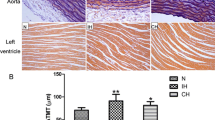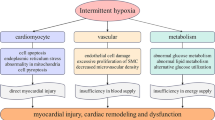Abstract
Obstructive sleep apnea (OSA), characterized by intermittent hypoxia (IH) during sleep, is increasingly recognized as an independent risk factor of cardiovascular diseases. OSA is associated with changes in the levels of circulating oxidative stress/inflammatory markers and dyslipidemia, supporting their mediating roles in cardiovascular pathogenesis. Our aims were to investigate the effect of IH on heart tissue using an IH-exposed rat model and to explore the potential mechanisms involved in the occurrence of cardiac damage. Male Sprague–Dawley rats were exposed to IH and intermittent normoxia as control and sacrificed after 2 or 4 weeks. IH for 4 weeks caused elevation in serum malondialdehyde and cytokine-induced neutrophil chemoattractant-1 and reduction in serum adiponectin levels. In contrast, cardiac oxidative stress and pro-inflammatory markers were suppressed while cardiac adiponectin and cholesterol levels were elevated after IH exposure for 4 weeks. In parallel, there was an increase in apoptosis in the heart of IH-exposed rats, demonstrated by elevations of Bax and cleaved caspase-3 protein and TUNEL staining. Cardiac damage was further evident with decreased arterial vessel and capillary densities, increased cardiac fibrosis, and the loss of troponin I. Our data demonstrated that IH exposure paradoxically caused systemic oxidative and inflammatory responses and cardioprotective responses, i.e., anti-oxidative and anti-inflammatory responses. Despite such a local compensatory protective mechanism, cardiac damage was observed that might be due to IH-induced cholesterol accumulation in the heart and caspase-dependent apoptosis.






Similar content being viewed by others
Abbreviations
- BMI:
-
Body mass index
- CO:
-
Carbon monoxide
- CVDs:
-
Cardiovascular diseases
- CPAP:
-
Continuous positive airway pressure
- Nrf2:
-
Erythroid 2-related factor
- HO-1:
-
Heme oxygenase-1
- HDL:
-
High-density lipoprotein
- IL-6:
-
Interleukin-6
- IH:
-
Intermittent hypoxia
- Keap-1:
-
Kelch-like ECH-associated protein
- LDL:
-
Low-density lipoprotein
- MDA:
-
Malondialdehyde
- ROS:
-
Reactive oxygen species
- SMA:
-
Smooth muscle actin
- TNF-α:
-
Tumor necrosis factor-α
- vWF:
-
von Willebrand factor
References
Arnardottir ES, Mackiewicz M, Gislason T, Teff K, Pack AI (2009) Molecular signatures of obstructive sleep apnea in adults: a review and perspective. Sleep 32:447–470
Baldi A, Abbate A, Bussani R, Patti G, Melfi R, Angelini A, Dobrina A, Rossiello R, Silvestri F, Baldi F, Di Sciascio G (2002) Apoptosis and post-infarction left ventricular remodeling. J Mol Cell Cardiol 34:165–174
Burckhardt IC, Gozal D, Dayyat E, Cheng Y, Li RC, Goldbart AD, Row BW (2008) Green tea catechin polyphenols attenuate behavioral and oxidative responses to intermittent hypoxia. Am J Respir Crit Care Med 177:1135–1141
Carpagnano GE, Kharitonov SA, Resta O, Foschino-Barbaro MP, Gramiccioni E, Barnes PJ (2002) Increased 8-isoprostane and interleukin-6 in breath condensate of obstructive sleep apnea patients. Chest 122:1162–1167
Chen L, Einbinder E, Zhang Q, Hasday J, Balke CW, Scharf SM (2005) Oxidative stress and left ventricular function with chronic intermittent hypoxia in rats. Am J Respir Crit Care Med 172:915–920
Chin K, Ohi M, Shimizu K, Nakamura T, Miyaoka F, Mishima M (2001) Increase in bilirubin levels of patients with obstructive sleep apnea in the morning—a possible explanation of induced heme oxygenase-1. Sleep 24:218–223
Ciftci TU, Kokturk O, Bukan N, Bilgihan A (2004) The relationship between serum cytokine levels with obesity and obstructive sleep apnea syndrome. Cytokine 28:87–91
El Solh AA, Akinnusi ME, Baddoura FH, Mankowski CR (2007) Endothelial cell apoptosis in obstructive sleep apnea: a link to endothelial dysfunction. Am J Respir Crit Care Med 175:1186–1191
Greenberg H, Ye X, Wilson D, Htoo AK, Hendersen T, Liu SF (2006) Chronic intermittent hypoxia activates nuclear factor-[kappa]b in cardiovascular tissues in vivo. Biochem Biophys Res Commun 343:591–596
Imagawa S, Yamaguchi Y, Ogawa K, Obara N, Suzuki N, Yamamoto M, Nagasawa T (2004) Interleukin-6 and tumor necrosis factor-a in patients with obstructive sleep apnea-hypopnea syndrome. Respiration 71:24–29
Kim J, Cha Y-N, Surh Y-J (2009) A protective role of nuclear factor-erythroid 2-related factor-2 (Nrf2) in inflammatory disorders. Mutat Res Fundam Mol Mech Mutagen 690:12–23
Kobayashi M, Miyazawa N, Takeno M, Murakami S, Kirino Y, Okouchi A, Kaneko T, Ishigatsubo Y (2008) Circulating carbon monoxide level is elevated after sleep in patients with obstructive sleep apnea. Chest 134:904–910
Kockx MM, De Meyer GRY, Muhring J, Jacob W, Bult H, Herman AG (1998) Apoptosis and related proteins in different stages of human atherosclerotic plaques. Circulation 97:2307–2315
Lam JCM, Ip MSM (2009) Obstructive sleep apnea and the metabolic syndrome. Expert Rev Respir Med 3:177–186
Lavie L (2009) Oxidative stress—a unifying paradigm in obstructive sleep apnea and comorbidities. Prog Cardiovasc Dis 51:303–312
Lee W, Xu M, Li Y, Gu Y, Chen J, Wong D, Fung PCW, Shen J (2011) Free cholesterol accumulation impairs antioxidant activities and aggravates apoptotic cell death in menadione-induced oxidative injury. Arch Biochem Biophys 514:57–67
Li J, Savransky V, Nanayakkara A, Smith PL, O’Donnell CP, Polotsky VY (2007) Hyperlipidemia and lipid peroxidation are dependent on the severity of chronic intermittent hypoxia. J Appl Physiol 102:557–563
Li J, Thorne LN, Punjabi NM, Sun C-K, Schwartz AR, Smith PL, Marino RL, Rodriguez A, Hubbard WC, O’Donnell CP, Polotsky VY (2005) Intermittent hypoxia induces hyperlipidemia in lean mice. Circ Res 97:698–706
Maines M (1988) Hemeoxygenase: function, multiplicity, regulatory mechanisms, and clinical applications. FASEB J 2:2557–2568
Masini E, Vannacci A, Marzocca C, Pierpaoli S, Giannini L, Fantappie O, Mazzanti R, Mannaioni PF (2003) Heme oxygenase-1 and the ischemia-reperfusion injury in the rat heart. Exp Biol Med 228:546–549
Nakagawa Y, Kishida K, Kihara S, Sonoda M, Hirata A, Yasui A, Nishizawa H, Nakamura T, Yoshida R, Shimomura I, Funahashi T (2008) Nocturnal reduction in circulating adiponectin concentrations related to hypoxic stress in severe obstructive sleep apnea-hypopnea syndrome. Am J Physiol Endocrinol Metab 294:E778–E784
Newman AB, Nieto FJ, Guidry U, Lind BK, Redline S, Shahar E, Pickering TG, Quan for the Sleep Heart Health Study Research Group SF (2001) Relation of sleep-disordered breathing to cardiovascular disease risk factors. Am J Epidemiol 154:50–59
Nishida K, Otsu K (2008) Cell death in heart failure. Circ J 72:A17–A21
Otterbein LE, Bach FH, Alam J, Soares M, Tao Lu H, Wysk M, Davis RJ, Flavell RA, Choi AMK (2000) Carbon monoxide has anti-inflammatory effects involving the mitogen-activated protein kinase pathway. Nat Med 6:422–428
Pekkanen J, Linn S, Heiss G, Suchindran CM, Leon A, Rifkind BM, Tyroler HA (1990) Ten-year mortality from cardiovascular disease in relation to cholesterol level among men with and without preexisting cardiovascular disease. N Engl J Med 322:1700–1707
Peterson SJ, Frishman WH (2009) Targeting hemeoxygenase: therapeutic implications for diseases of the cardiovascular system. Cardiol Rev 17:99–111
Ramirez TA, Jourdan-Le Saux C, Joy A, Zhang J, Dai Q, Mifflin S, Lindsey ML (2012) Chronic and intermittent hypoxia differentially regulate left ventricular inflammatory and extracellular matrix responses. Hypertens Res 35:811–818
Robinson GV, Pepperell JCT, Segal HC, Davies RJO, Stradling JR (2004) Circulating cardiovascular risk factors in obstructive sleep apnoea: data from randomised controlled trials. Thorax 59:777–782
Ryan S, Taylor CT, McNicholas WT (2006) Predictors of elevated nuclear factor-kb-dependent genes in obstructive sleep apnea syndrome. Am J Respir Crit Care Med 174:824–830
Selim B, Won C, Yaggi HK (2010) Cardiovascular consequences of sleep apnea. Clin Chest Med 31:203–220
Shamsuzzaman ASM, Gersh BJ, Somers VK (2003) Obstructive sleep apnea: implications for cardiac and vascular disease. JAMA 290:1906–1914
Somers VK, White DP, Amin R, Abraham WT, Costa F, Culebras A, Daniels S, Floras JS, Hunt CE, Olson LJ, Pickering TG, Russell R, Woo M, Young T (2008) Sleep apnea and cardiovascular disease. Circulation 118:1080–1111
Tabas I (2002) Consequences of cellular cholesterol accumulation: basic concepts and physiological implications. J Clin Invest 110:905–911
Ungvari ZI, Bailey-Downs L, Gautam T, Jimenez R, Losonczy G, Zhang C, Ballabh P, Recchia FA, Wilkerson DC, Sonntag WE, Pearson KJ, de Cabo R, Csiszar A (2011) Adaptive induction ofNf-E2-related factor-2-driven antioxidant genes in endothelial cells in response to hyperglycemia. Am J Physiol Heart C 300:H1133–H1140
Uno K, Nicholls SJ (2010) Biomarkers of inflammation and oxidative stress in atherosclerosis. Biomark Med 4:361–373
Vatansever E, Surmen-Gur E, Ursavas A, Karadag M (2011) Obstructive sleep apnea causes oxidative damage to plasma lipids and proteins and decreases adiponectin levels. Sleep Breath 15:275–282
Vgontzas AN, Papanicolaou DA, Bixler EO, Kales A, Tyson K, Chrousos GP (1997) Elevation of plasma cytokines in disorders of excessive daytime sleepiness: role of sleep disturbance and obesity. J Clin Endocrinol Metab 82:1313–1316
Wang Z, Si L-Y (2013) Hypoxia-inducible factor-1a and vascular endothelial growth factor in the cardioprotective effects of intermittent hypoxia in rats. Ups J Med Sci 118:65–74
Wolf J, Lewicka J, Narkiewicz K (2007) Obstructive sleep apnea: an update on mechanisms and cardiovascular consequences. Nutr Metab Cardiovasc Dis 17:233–240
Yao PM, Tabas I (2001) Free cholesterol loading of macrophages is associated with widespread mitochondrial dysfunction and activation of the mitochondrial apoptosis pathway. J Biol Chem 276:42468–42476
Yet SF, Tian R, Layne MD, Wang ZY, Maemura K, Solovyeva M, Ith B, Melo LG, Zhang L, Ingwall JS, Dzau VJ, Lee ME, Perrella MA (2001) Cardiac-specific expression of heme oxygenase-1 protects against ischemia and reperfusion injury in transgenic mice. Circ Res 89:168–173
Zhang XL, Yin KS, Wang H, Su S (2006) Serum adiponectin levels in adult male patients with obstructive sleep apnea hypopnea syndrome. Respiration 73:73–77
Acknowledgments
This work was supported by Hong Kong Research Grant Council General Research Fund (RGC GRF) 2008–2009 (HKU 771908M).
Conflict of interest
The authors report no conflicts of interest.
Author information
Authors and Affiliations
Corresponding author
Rights and permissions
About this article
Cite this article
Han, Q., Yeung, S.C., Ip, M.S.M. et al. Cellular mechanisms in intermittent hypoxia-induced cardiac damage in vivo. J Physiol Biochem 70, 201–213 (2014). https://doi.org/10.1007/s13105-013-0294-z
Received:
Accepted:
Published:
Issue Date:
DOI: https://doi.org/10.1007/s13105-013-0294-z




